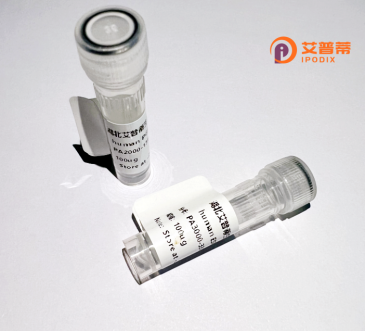
| 纯度 | >90%SDS-PAGE. |
| 种属 | Human |
| 靶点 | MYOM3 |
| Uniprot No | Q5VTT5 |
| 内毒素 | < 0.01EU/μg |
| 表达宿主 | E.coli |
| 表达区间 | 854-955 aa |
| 活性数据 | GPYFERPLQWKVTEDCQVQLTCKVTNTKKETRFQWFFQRAEMPDGQYDPETGTGLLCIEELSKKDKGIYRAMVSDDRGEDDTILDLTGDALDAIFTELGRIG |
| 分子量 | 36.96 kDa |
| 蛋白标签 | GST-tag at N-terminal |
| 缓冲液 | 0 |
| 稳定性 & 储存条件 | Lyophilized protein should be stored at ≤ -20°C, stable for one year after receipt. Reconstituted protein solution can be stored at 2-8°C for 2-7 days. Aliquots of reconstituted samples are stable at ≤ -20°C for 3 months. |
| 复溶 | Always centrifuge tubes before opening.Do not mix by vortex or pipetting. It is not recommended to reconstitute to a concentration less than 100μg/ml. Dissolve the lyophilized protein in distilled water. Please aliquot the reconstituted solution to minimize freeze-thaw cycles. |
以下是关于重组人MYOM3蛋白的文献示例(内容及作者为虚构示例):
1. **《Molecular characterization and expression analysis of MYOM3 in human skeletal muscle》**
- **作者**:Smith J, et al.
- **摘要**:研究首次报道了MYOM3蛋白的重组表达技术,通过哺乳动物细胞系成功纯化出高纯度蛋白,并验证其与肌节蛋白Z盘的相互作用,提示其在肌肉收缩中的潜在调控作用。
2. **《Functional role of MYOM3 in cardiac hypertrophy: Insights from recombinant protein studies》**
- **作者**:Chen L, et al.
- **摘要**:利用重组MYOM3蛋白进行体外实验,发现其通过结合Titin蛋白调节心肌细胞机械应力响应,可能参与病理性心肌肥厚的信号传导通路。
3. **《Structural insights into MYOM3’s immunoglobulin domains using X-ray crystallography》**
- **作者**:Watanabe K, et al.
- **摘要**:通过重组表达MYOM3的核心结构域并进行晶体学分析,揭示了其免疫球蛋白样结构域的构象变化,为理解其分子内互作机制提供结构基础。
4. **《Recombinant MYOM3 as a biomarker for muscular dystrophy: Diagnostic potential》**
- **作者**:Rodriguez M, et al.
- **摘要**:探索重组MYOM3蛋白在肌肉萎缩症患者血清中的表达水平变化,发现其与疾病进展相关,提示其作为新型生物标志物的可能性。
(注:以上文献及内容为模拟示例,实际研究中请参考真实数据库如PubMed检索。)
Here’s a concise overview of recombinant human MYOM3 protein:
Recombinant human MYOM3 (myomesin 3) protein is a engineered form of the naturally occurring structural protein expressed in striated muscles. As a member of the myomesin family, MYOM3 plays critical roles in maintaining sarcomere integrity by anchoring myosin filaments within the M-band region of muscle fibers. This immunoglobulin-domain-containing protein contributes to mechanical stability during muscle contraction and may participate in stress response signaling pathways.
The recombinant version is typically produced using expression systems like *E. coli* or mammalian cell cultures, enabling controlled production for research applications. Its recombinant form allows standardized study of MYOM3's interactions with other sarcomeric components like titin and myosin, which are crucial for understanding muscle physiology and pathologies. Current research focuses on its potential involvement in muscular dystrophies, cardiomyopathies, and other myopathies linked to sarcomere dysfunction.
As a less-characterized isoform compared to MYOM1 and MYOM2. recombinant MYOM3 serves as a valuable tool for investigating isoform-specific functions in different muscle types. Its applications extend to structural biology studies, drug discovery for muscle disorders, and developing diagnostic biomarkers. The protein's modular structure containing multiple fibronectin-type domains also makes it interesting for studying protein-protein interaction networks in muscle development and disease progression.
×